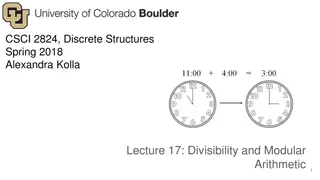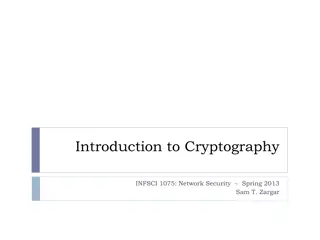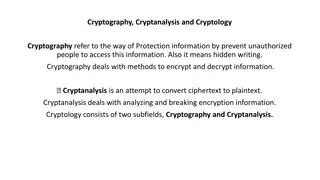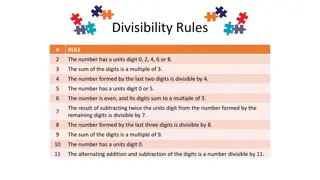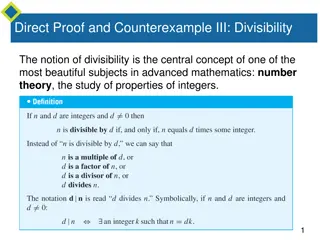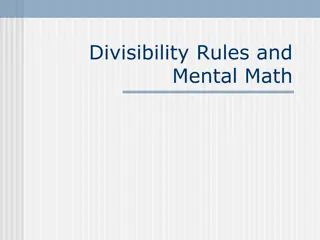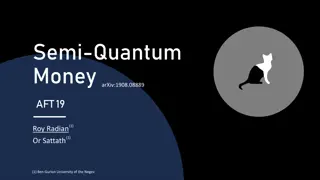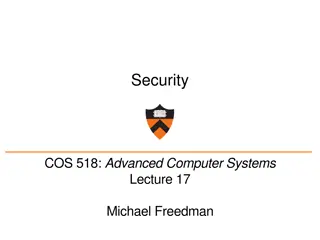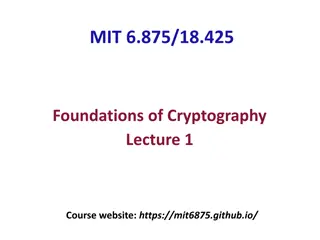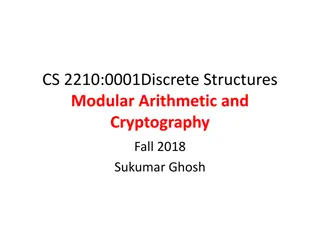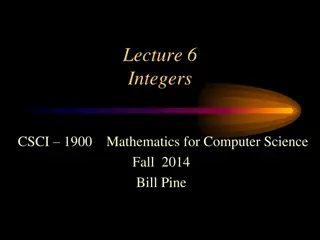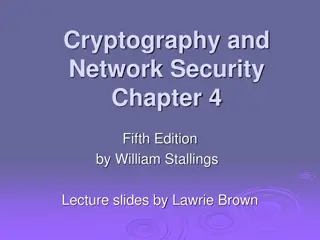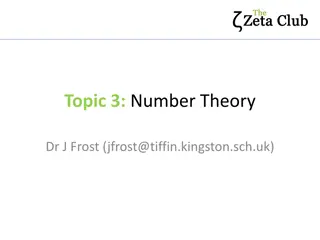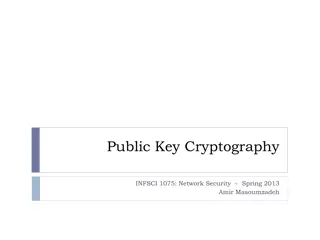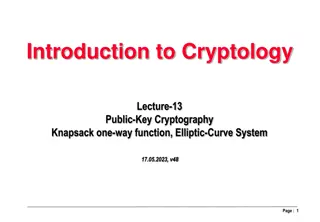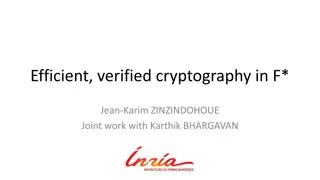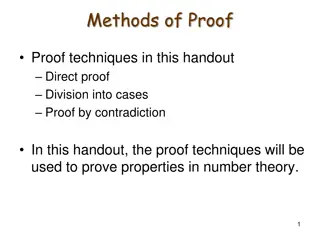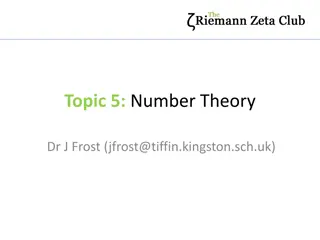Understanding Cryptography: Basic Concepts in Number Theory and Divisibility
This text delves into the fundamental concepts of number theory, divisibility, and finite fields essential for understanding cryptography. It covers topics such as divisibility, properties of divisibility, the division algorithm, the Euclidean algorithm for determining the greatest common divisor, and the significance of the greatest common divisor (GCD) in cryptography. Exploring these foundational mathematical principles provides a strong basis for delving into the intricate world of encryption and network security.
Download Presentation

Please find below an Image/Link to download the presentation.
The content on the website is provided AS IS for your information and personal use only. It may not be sold, licensed, or shared on other websites without obtaining consent from the author. Download presentation by click this link. If you encounter any issues during the download, it is possible that the publisher has removed the file from their server.
E N D
Presentation Transcript
Introduction to Cryptography Based on: William Stallings, Cryptography and Network Securityy
Chapter 4 Basic Concepts in Number Theory and Finite Fields
Divisibility We say that a nonzero b divides a if a = mb for some m, where a, b, and m are integers The notation b | a means b divides a If b | a we say that b is a divisor of a The positive divisors of 24 are 1, 2, 3, 4, 6, 8, 12, and 24 13 | 182; - 5 | 30; 17 | 289; - 3 | 33; 17 | 0 3
Properties of Divisibility If a | 1, then a = 1 If a | b and b | a, then a = b Any b 0 divides 0 If a | b and b | c, then a | c 11 | 66 and 66 | 198 11 | 198 If b | g and b | h, then b | (mg + nh) for arbitrary integers m and n 4
Division Algorithm Given any positive integer n and any nonnegative integer a, if we divide a by n we get an integer quotientq and an integer remainderr such that: a = qn + r, 0 r < n; q = [a/n] 5
q is the quotient r is the remainder 6
Procedure to determine the greatest common divisor of two positive integers Euclidean Algorithm Two integers are relatively prime if their only common positive integer factor is 1 7
Greatest Common Divisor (GCD) The greatest common divisor of a and b denoted by gcd(a,b) is the largest positive integer that divides both a and b We define gcd(0,0) = 0 A positive integer c is the gcd of a and b if: c is a divisor of a and b any divisor of a and b is a divisor of c 8
GCD Because the gcd positive, gcd(a,b) = gcd(a,-b) = gcd(-a,b) = gcd(-a,-b) gcd(60, 24) = gcd(60, - 24) = 12 Also, gcd(a,0) = | a | Integers a and b are relatively prime if gcd(a,b) = 1 8 and 15 are relatively prime because: the positive divisors of 8 are 1, 2, 4, and 8, and the positive divisors of 15 are 1, 3, 5, and 15. 9
Euclidean Algorithm Example Find the greatest common divisor of a = 1160718174 and b = 316258250 10
Modular Arithmetic The modulus If a and n are positive integer, we define a mod n to be the remainder when a is divided by n; the integer n is called the modulus That is: r = a mod n, when a = qn + r with 0 r < n 11 mod 7 = 4; - 11 mod 7 = 3 11
Modular Arithmetic Congruence modulo n Integers a and b are congruent modulo n if (a mod n) = (b mod n) This is written as a b (mod n) 73 4 (mod 23); 21 -9 (mod 10) N. B. a b (mod n) if n |(a b) 12
Properties of Congruences Congruences have the following properties: 1. a b (mod n) if n |(a b) 2. a b (mod n) implies b a (mod n) 3. a b (mod n) and b c (mod n) imply a c (mod n) 23 8 (mod 5) because 23 - 8 = 15 = 5 * 3 -11 5 (mod 8) because -11 - 5 = -16 = 8 * (-2) 81 0 (mod 27) because 81 - 0 = 81 = 27 * 3 13
Arithmetic Modulo 8 (in ?8) ?8= {0,1,...,7} 14
Additive and Multiplicative Inverses Modulo 8 16
Extended Euclidean Algorithm Example Given positive integers a,b: find integers ?,?,? such that ?? + ?? = ? ? ? ?1 = ?3?2 + ?3 ?? 2= ???? 1+ ?? ?? 1= ??+1??+ 0 = ?1? + ?1 = ?2?1 + ?2 ?1 = ??1+ ??1 ?2 = ??2+ ??2 ?3 = ??3+ ??3 ? = ?? = ???+ ??? 17
Groups A set of elements G with a binary operation denoted by is an abelian group if: For all a, b in G we have a b in G for all a, b, c in G we have a (b c) = (a b) c there is an element e in G such that a e = e a = a for all a in G for each a in G, there is an element b (= ? 1) in G such that a b = b a = e for all a, b in G we have a b = b a 18
Cyclic Group Let ?? = a a a a (?-times) Let a0 = e, the identity element, and ? ?= (? 1)?, where ? 1 is the inverse element of a in G A group G is cyclic if every element of G is a power ?? (?is an integer) of a fixed element of G The element a is said to generate the group G or to be a generator of G 19
Fields A field is a set F of elements with two binary operations, called addition (+) and multiplication ( ), such that for all a , b , c in F: F is an commutative group with respect to addition a b is in F a b = b a a (b c ) = (a b) c a (b + c) = a b + a c and (a + b ) c = a c + b c there is an element 1 in F such that: a 1 = 1 a = a for all a in F In particular, we can do addition, subtraction and multiplication without leaving F. 20
Finite Fields ?? ??,? a prime Finite fields play a crucial role in many cryptographic algorithms It can be shown that the order of a finite field must be a power of a prime ??, where n is a positive integer The finite field of order ?? is written ?? ?? GF stands for Galois field, in honor of the mathematician who first studied finite fields 21
Arithmetic in GF(7) = ?7 (a) Addition modulo 7 22
Arithmetic in GF(7) = ?7 (b) Multiplication modulo 7 23
Arithmetic in ?7 24
1. GF(p) = {0, 1, . . . , p 1} 2. GF(p) has two binary operations addition (+) and multiplication ( ) . GF(p), p a prime The operations of addition, subtraction, multiplication, and division can be performed without leaving the set. is a finite field of order p, with the following properties: Each non-zero element of the GF(p) has a multiplicative inverse 25
Polynomial Arithmetic We distinguish three classes of polynomial arithmetic: Polynomial arithmetic, using the basic rules of algebra Polynomial arithmetic in which the arithmetic on the coefficients is performed modulo p (in GF(p)) Polynomial arithmetic in which the coefficients are in GF(p ), and the polynomials are defined modulo a polynomial m (x). 26
Ordinary Polynomial Arithmetic Example Let f(x) = x3 + x2+ 2 and g(x) = x2 - x + 1, be polynomials with integer coefficients Then: f(x) + g(x) = x3 + 2x2 - x + 3 f(x) - g(x) = x3 + x + 1 f(x) g(x) = x5 + 3x2 - 2x + 2 27
Polynomial Arithmetic with coefficients modulo p, Example Let f(x) = x3 + 2x2+ 5 and g(x) = 6x2 + 5x + 3, be polynomials with coefficients modulo 7 Then: f(x) + g(x) = x3 + x2+5x + 1 f(x) - g(x) = x3 + 3x2+ 2x + 2 f(x) g(x) = 6x5 + 3x4+6x3 + 4x + 1 28
Polynomial Arithmetic with coefficients in ?? When polynomial arithmetic is performed on polynomials over a field, modulo an irreducible or prime polynomial then division is possible If we attempt to perform polynomial division over a coefficient set that is not a field, we find that division is not always defined 29
Polynomial Division We can write any polynomial in the form: f(x) = q(x) g(x) + r(x) r(x) can be interpreted as being a remainder So r(x) = f(x) mod g(x) If there is no remainder we can say g(x)divides f(x) Written as g(x) | f(x) We can say that g(x) is a factor of f(x), or g(x) is a divisor of f(x) A polynomial f(x) over a field F is called irreducible if and only if f(x) cannot be expressed as a product of two polynomials, both over F, and both of degree lower than that of f(x) An irreducible polynomial is also called a prime polynomial 30
Example of Polynomial Arithmetic over ??(2) 31
Arithmetic in ?? 23 (a) Addition 32
Arithmetic in ??(23) (modulo the irreducible polynomial ?3+ ? + 1) (b) Multiplication 33
Arithmetic in ??(23) = {1,2,3,4,5,6,7}, where 0=000,1=100,2=010, 3=011, 4=100, 5=101, 6=110, 7=111 34
Summary Divisibility and the division algorithm Finite fields of the form ??(?) = ?? The Euclidean algorithm Polynomial arithmetic Finite fields ??(2?) Modular arithmetic Groups, rings, and fields 35



